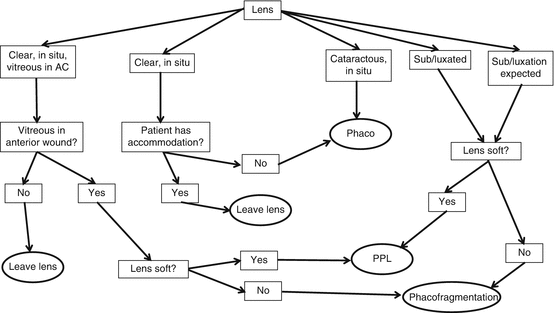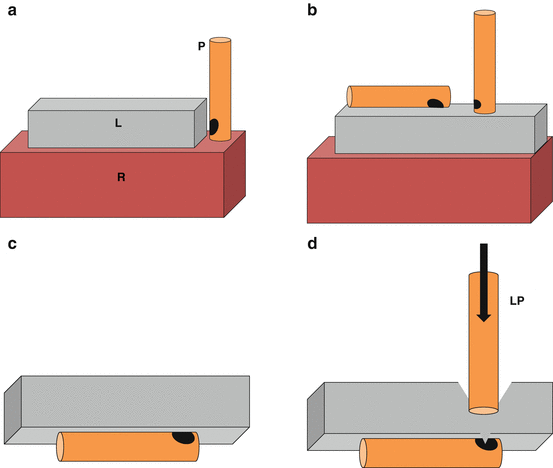(1)
St. Johns, FL, USA
(2)
Helen Keller Foundation for Research and Education, International Society of Ocular Trauma, Birmingham, AL, USA
(3)
Consultant and Vitreoretinal Surgeon, Milos Eye Hospital, Belgrade, Serbia
(4)
Consultant and Vitreoretinal Surgeon, Zagórskiego Eye Hospital, Cracow, Poland
There are advantages and disadvantages to combining cataract removal (and typically IOL implantation) with the vitrectomy (see Table 4.2). This chapter is primarily dedicated to the technical issues of combined surgery. The decision-making process regarding the type of lens removal technique is shown in Fig. 38.1.


Fig. 38.1
Decision-making tree about the lens in the eyes undergoing VR surgery. See the text for more details
The question whether a clear lens needs to be removed in the eye that has no (or only weak) accommodation has no straightforward answer. The surgeon must not hesitate to remove the lens if its presence would interfere with the success of the vitrectomy; otherwise, he should discuss it with the patient (see Chap. 5), although other issues are also at play (see Sect. 4.6).
Pearl
The condition of the retina and the ciliary body determines the operation’s success, not whether the lens was preserved.
38.1 Phacoemulsification
The operation is done similar to how it is normally performed; only a few unique suggestions are made here. The cataract surgery precedes the vitrectomy unless special circumstances exist.
Place the cannula for the infusion first1; whether the two additional cannulas are also inserted now or later is up to you. The infusion line need not be connected until the PPV commences.
Do not make the capsulorhexis larger than ~5 mm.
Occasionally2 it is best to keep the visco in the AC until the PPV has been completed.
Always perform a posterior capsulectomy after the IOL has been implanted.
38.2 Lensectomy
If the surgeon knows that the lens capsules must also be removed (see below), the pars plana lensectomy approach offers familiarity in technique and access.3 PPL is very effective as long as the lens material is soft4; otherwise, the probe will be able to remove the cortex but little of the nucleus.
38.2.1 Lens In Situ
Always use the superotemporal sclerotomy for access.
Q&A
Q
Why not use the superonasal sclerotomy for lens in situ PPL or phacofragmentation?
A
The probe must be held horizontally, which is impossible if the nose is in the way. The surgeon should use a finger of his other hand to securely keep the probe in position (see Fig. 2.1).
Insert a 23 g needle and slice the capsule open at the equator. The goal is to provide a resistance-free entrance into the lens for the blunt probe.5
Push the probe into the lens. Turn the port sideways to avoid biting into either capsules.
A soft lens requires aspiration only; the cutting function needs to be activated only if the lens nucleus is hard or the material obstructs the outflow.6
It is very difficult to avoid injuring the posterior capsule. Small lens particles are likely to fall posteriorly, but they can easily be removed during the subsequent vitrectomy.
Pearl
The posterior capsule is virtually impossible to preserve during PPL. The infusion is not directly inflating the capsular bag, which therefore starts to collapse during lens removal and progressively moves closer and closer to the probe’s tip. This, unlike the distance between the anterior capsule and the port, cannot be monitored.
38.2.2 Lens in the Vitreous8
Complete the vitrectomy first, including the creation of a PVD.
Change the settings on the machine: lower the cut rate to 100–300 cps and increase the aspiration/flow as needed.9
If the cut rate is high and the lens material is hard, occlusion of the port becomes impossible and the lens fragment will keep being pushed away.
Soft material10 is easy to remove.
If the nucleus is hard,11 utilizing the light pipe as a “crusher” may obviate the need for ultrasound.
Using aspiration only and with the port turned toward the retina, lift the piece into the midvitreous cavity, at a safe distance from the retina.
Do not take your foot off the pedal; continue aspirating so that the piece does not fall back.
Turn the probe 180° so that it is now underneath the lens particle.
Use the light pipe to “force-feed” the lens material into the port (see Fig. 38.2). The particles may time-to-time clog the probe, requiring the nurse to flush it.

Fig. 38.2
Schematic representation of removing hard lens particles from the vitreous cavity. (a) The probe (P) is able to bite into the lens particle (L) only if it can attack it from the smallest dimension of the particle; however, this may be dangerous because the tip of the probe can be pushed into the retina (R). (b) It is easy to engage the particle from above (left hand side), but this does not allow any bite into the particle since the material is hard and the surface area too large. In addition, the high aspiration rate makes cutting in this position risky. On the right hand side, the cutter is unable to engage the tissue, whether it is the lens or a sheet of vitreous over the retina, because there is no edge. (c) Picking up the particle and bringing it away from the retina increase safety. The probe is rotated so that the port now faces the surgeon; the lens particle is not lost because the (high) aspiration/flow is maintained. However, the probe still cannot bite into the particle because it is hard and the area of contact is too large. (d) The light pipe (LP) is able to push the particle into the port. The particle is either gradually eaten (at a low cpm rate) or, more commonly, broken into smaller pieces. The pieces must have at least one side that is small enough to be fed into the port
Repeat the entire sequence until all pieces are removed.
Alternatively, after you brought the hard piece into the midvitreous cavity, hold it there so that you can view it with the BIOM switched out, and exchange the light pipe for a forceps. Grab the piece so that its smallest dimension can be turned toward the probe, and feed it into the port.
After all visible lens particles are gone, irrigate the vitreous cavity to bring into view and remove any previously hidden or miniscule, circulating pieces; these would increase the postoperative inflammation.
38.3 Phacofragmentation12
The indications to use a pars plana approach to remove the lens are similar to those listed under PPL (see above), as is the rule to utilize the temporal sclerotomy for lens removal.
Adjust the pedal function to operating the machine in phacofragmentation mode.13
38.3.1 Lens In Situ
Place the cannula for the infusion and for the temporal working sclerotomy14 first; whether the superonasal cannula is also inserted now or later is up to you.
Do a judicious anterior vitrectomy.15
Insert the phacofragmentor and remove the lens material.
Use the “nibbling” technique, advancing the probe in small and gradual steps, not by making long tunnels in the lens. This technique increases the chance that the port is always occluded.
Stay updated, free articles. Join our Telegram channel

Full access? Get Clinical Tree


